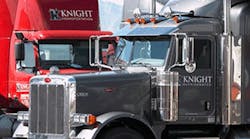High fuel prices, a continued shortage of drivers, and growing uncertainty over tonnage growth are concerns that marked the first quarter earnings reports from for-fire carriers, both TL and LTL alike.
Also, though revenues and profits increased for many, most noted the freight driving such improvements came from gains in market share and broader “diversification” efforts from intermodal and brokerage operations.
“Our first-quarter revenue reflected a 10.7% increase in tonnage and a 5.5% increase in revenue per hundredweight as compared with the first quarter of 2011,” noted David Congdon, president and CEO of Old Dominion Freight Line (ODFL).” The increase in tonnage is the result of a 9.5% increase in shipments and a 1% increase in weight per shipment. But while the domestic economy appears to be slightly improving, we attribute our quarter-over-quarter growth in revenue and tonnage primarily to gains in market share.”
Congdon noted ODFL’s net income reached $31.1 million on revenues of $497.1 million in the first quarter this year – increases of 44.1% and 17.6%, respectively, compared to the same period in 2011 – that helped the carrier improve its operating ratio to 89.1% from 91%.
Knight Transportation, on the other hand, noted that efforts to diversify its trucking services are significantly aiding its ability to grow both revenues and profits.
While Knight said revenue per tractor improved 10.3% in the first quarter – a result of a 7.3% improvement in miles per tractor, a 2.8% improvement in revenue per total mile, and a 2.6% longer length of haul – the biggest revenue growth occurred in its port/rail intermodal division (27.9%) and brokerage business (20%) versus its core dry van operation (9.1%) and refrigerated division (13.7%).
Kevin Knight, the company’s chairman and CEO, said the carrier’s net income increased to $10.5 million on 17.7% higher total revenues of $219.5 million in the first quarter this year versus the same period in 2011, but that high fuel costs and a still–problematic driver shortage will make sustaining such growth more difficult.
“Sustained higher fuel prices continue to be a challenge for the industry. In the first quarter of 2012 the average price of diesel increased 9.8% when compared to the same period last year,” he said. “Driver availability remains one of our major concerns this year as we experienced a tightening driver market in the latter part of first quarter 2012. Successfully sourcing and retaining drivers will be critical in our ability to continue to grow our asset-based businesses.”
Such “costs pressures” are already causing trouble for other carriers, notably Covenant Transportation Group, which lost $600,000 on 2% lower freight revenue of $121.9 million in the first quarter this year – better than the $2.5 million the carrier lost in the first quarter of 2011, but a loss nonetheless and one related to intensifying difficulties where fuel prices and driver wages are concerned.
“During the quarter freight demand was reasonably good and customers continued to express concern about accessing adequate truckload capacity during the upcoming seasonally stronger months of the year. We were encouraged by an approximately 5.8% increase in average freight revenue per total mile,” noted David Parker, Covenant’s chairman, president, and CEO.
“But continued progress on yield improvement and efficiency will be necessary as our industry faces cost pressure from driver wages, fuel and equipment prices, insurance and health care, and other expenses, as well as utilization pressure from regulatory and other sources,” he stressed.
Parker noted that Covenant’s salaries, wages and related expenses increased approximately 4.2 cents per mile due to driver pay adjustments since the first quarter of 2011 and higher workers' compensation expense, with insurance and claims per mile cost increased to 11.8 cents per mile in the first quarter as well.
Finally, operations and maintenance expense increased approximately one cent per mile compared with the first quarter of 2011 primarily because of inflationary pressures related to tires and vehicle parts, he noted.
“For fuel, higher costs at the pump were offset by fuel efficiencies and benefits from our hedging strategies that led to a decrease in our net per mile cost of fuel,” he pointed out. “Fuel prices as measured by the Department of Energy averaged approximately 35 cents per gallon or 9.7% higher in the first quarter of 2012 compared with the same quarter in 2011. However, with improved fuel economy, benefits from fuel hedging, and improved fuel surcharge recovery, we were able to reduce our per mile cost of fuel, net of fuel surcharge revenue, by approximately 5 cents per company mile compared with the first quarter of 2011.”
Parker said Covenant will continue managing our idle time and truck speeds, invest in more fuel-efficient tractors to improve fuel miles per gallon, adjust its fuel surcharge programs as needed, and use fuel hedges from time to time to reduce its exposure to rapid increases in fuel prices going forward.



